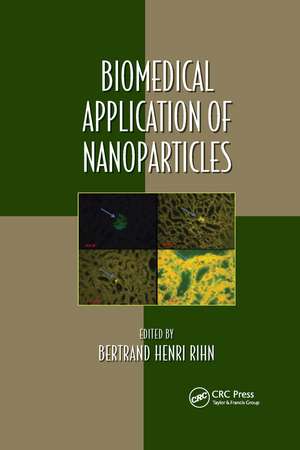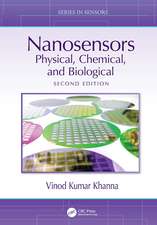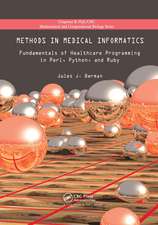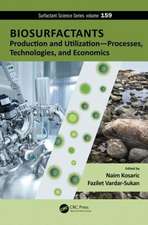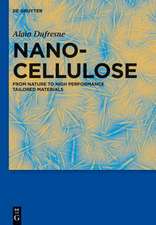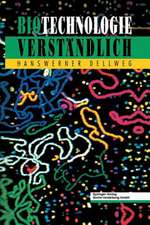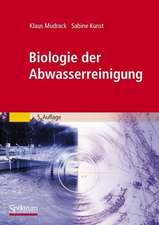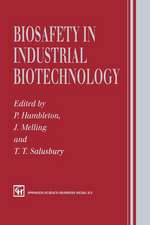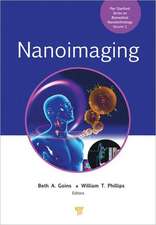Biomedical Application of Nanoparticles: Oxidative Stress and Disease
Editat de Bertrand Henri Rihnen Limba Engleză Paperback – 18 dec 2020
| Toate formatele și edițiile | Preț | Express |
|---|---|---|
| Paperback (1) | 316.54 lei 6-8 săpt. | |
| CRC Press – 18 dec 2020 | 316.54 lei 6-8 săpt. | |
| Hardback (1) | 879.65 lei 6-8 săpt. | |
| CRC Press – 7 sep 2017 | 879.65 lei 6-8 săpt. |
Din seria Oxidative Stress and Disease
-
 Preț: 356.64 lei
Preț: 356.64 lei -
 Preț: 379.25 lei
Preț: 379.25 lei - 18%
 Preț: 1330.94 lei
Preț: 1330.94 lei - 11%
 Preț: 319.88 lei
Preț: 319.88 lei - 15%
 Preț: 556.99 lei
Preț: 556.99 lei - 25%
 Preț: 410.54 lei
Preț: 410.54 lei - 29%
 Preț: 1188.26 lei
Preț: 1188.26 lei -
 Preț: 436.95 lei
Preț: 436.95 lei - 18%
 Preț: 785.60 lei
Preț: 785.60 lei -
 Preț: 447.52 lei
Preț: 447.52 lei -
 Preț: 441.97 lei
Preț: 441.97 lei -
 Preț: 437.13 lei
Preț: 437.13 lei -
 Preț: 356.61 lei
Preț: 356.61 lei - 33%
 Preț: 712.64 lei
Preț: 712.64 lei - 18%
 Preț: 1119.30 lei
Preț: 1119.30 lei - 18%
 Preț: 1343.11 lei
Preț: 1343.11 lei - 5%
 Preț: 603.59 lei
Preț: 603.59 lei - 18%
 Preț: 1340.43 lei
Preț: 1340.43 lei - 18%
 Preț: 1349.89 lei
Preț: 1349.89 lei - 18%
 Preț: 2235.06 lei
Preț: 2235.06 lei - 18%
 Preț: 1000.27 lei
Preț: 1000.27 lei - 15%
 Preț: 470.32 lei
Preț: 470.32 lei -
 Preț: 458.67 lei
Preț: 458.67 lei - 10%
 Preț: 317.80 lei
Preț: 317.80 lei - 5%
 Preț: 1038.51 lei
Preț: 1038.51 lei - 5%
 Preț: 1290.50 lei
Preț: 1290.50 lei -
 Preț: 431.18 lei
Preț: 431.18 lei - 18%
 Preț: 1866.69 lei
Preț: 1866.69 lei - 26%
 Preț: 1414.22 lei
Preț: 1414.22 lei - 28%
 Preț: 1525.52 lei
Preț: 1525.52 lei - 29%
 Preț: 1407.70 lei
Preț: 1407.70 lei - 26%
 Preț: 1299.29 lei
Preț: 1299.29 lei - 28%
 Preț: 1576.34 lei
Preț: 1576.34 lei - 26%
 Preț: 1351.70 lei
Preț: 1351.70 lei - 28%
 Preț: 1415.04 lei
Preț: 1415.04 lei - 21%
 Preț: 1497.55 lei
Preț: 1497.55 lei - 25%
 Preț: 1052.93 lei
Preț: 1052.93 lei
Preț: 316.54 lei
Preț vechi: 373.79 lei
-15% Nou
Puncte Express: 475
Preț estimativ în valută:
60.58€ • 65.78$ • 50.88£
60.58€ • 65.78$ • 50.88£
Carte tipărită la comandă
Livrare economică 23 aprilie-07 mai
Preluare comenzi: 021 569.72.76
Specificații
ISBN-13: 9780367735814
ISBN-10: 0367735814
Pagini: 352
Dimensiuni: 156 x 234 mm
Greutate: 0.65 kg
Ediția:1
Editura: CRC Press
Colecția CRC Press
Seria Oxidative Stress and Disease
ISBN-10: 0367735814
Pagini: 352
Dimensiuni: 156 x 234 mm
Greutate: 0.65 kg
Ediția:1
Editura: CRC Press
Colecția CRC Press
Seria Oxidative Stress and Disease
Cuprins
Variety of nanoparticle their synthesis and physicochemical determination. Nanoparticle world: history and introduction to their diversity. Manufacturing nanoparticles: a chemist approach. Manufacturing nanoparticles: a pharmacist approach. Methods for physico-chemical composition determination. Metrology of nanoparticles. Interaction with biological systems. Nanoparticle interaction with proteins: corona formation. Nanoparticle interaction with immune system. Cell uptake and internalization. Response of living systems to nanoparticles. Tools and methods for living system response investigation. Determination of effect biomarkers in cell, e.g. of NCF1 gene. Oxidative stress pathways involved following nanoparticle uptake. Involvement of necrosis, apoptosis or autophagy pathways. Nanoparticle and cell differentiation. Safety assessment of nanoparticle human use. Rodent inhalation studies for nanoparticles. The problem of barrier crossing: skin, placenta and brain barrier. Cell and coculture paradigms in safety assessment. Screening for genotoxicity using toxicogenomics. Nanoparticle and mitochondrion interaction. Medical use of nanoparticles. Nanoparticles and drug delivery: past present and future. Nanoparticles as vehicle of antioxidants. Nanoparticles in imaging for cancer early diagnosis. Phototherapy using drug encapsulated agents in cancer. Nanoparticle therapeutic in degenerative diseases. Nanoparticle in cosmetics. Current use of nanoparticle in the 3 Pharmacopeia.
Notă biografică
Bertrand Henri Rihn, MD, DSc, professor of biochemistry and molecular biol-ogy at Lorraine University, France, is a leading expert in the field of particulate toxicology, with research topics including safety toxicology, immunotoxicology, and investigating the transcriptomic changes in macrophages following nanopar-ticle exposure. In addition to his research, Professor Rihn has also worked as a clinical toxicologist, and was awarded the Baratz Award (2004) and the E. Taub Award (2011) from the National Academy of Medicine (France). He also served as the president of the French Society of Toxicology from 2007 to 2009, and was a EUROTOX Registered Toxicologist.
Descriere
This book explores nanoparticles, their chemical and physicals properties, and how they interact in biological systems with proteins, immune systems and targeted cells. Risk assessment of nanoparticles for human use is described, including: cellular paradigms, transcriptomics and toxicogenomics.
